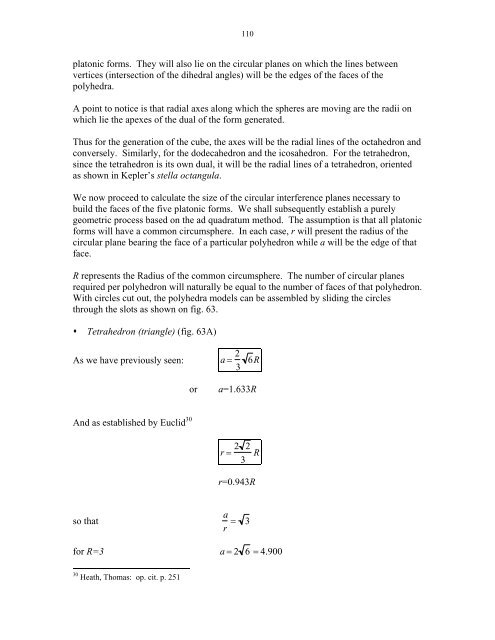Ad Quadratum Construction and Study of the Regular Polyhedra
Ad Quadratum Construction and Study of the Regular Polyhedra
Ad Quadratum Construction and Study of the Regular Polyhedra
Create successful ePaper yourself
Turn your PDF publications into a flip-book with our unique Google optimized e-Paper software.
platonic forms. They will also lie on <strong>the</strong> circular planes on which <strong>the</strong> lines between<br />
vertices (intersection <strong>of</strong> <strong>the</strong> dihedral angles) will be <strong>the</strong> edges <strong>of</strong> <strong>the</strong> faces <strong>of</strong> <strong>the</strong><br />
polyhedra.<br />
110<br />
A point to notice is that radial axes along which <strong>the</strong> spheres are moving are <strong>the</strong> radii on<br />
which lie <strong>the</strong> apexes <strong>of</strong> <strong>the</strong> dual <strong>of</strong> <strong>the</strong> form generated.<br />
Thus for <strong>the</strong> generation <strong>of</strong> <strong>the</strong> cube, <strong>the</strong> axes will be <strong>the</strong> radial lines <strong>of</strong> <strong>the</strong> octahedron <strong>and</strong><br />
conversely. Similarly, for <strong>the</strong> dodecahedron <strong>and</strong> <strong>the</strong> icosahedron. For <strong>the</strong> tetrahedron,<br />
since <strong>the</strong> tetrahedron is its own dual, it will be <strong>the</strong> radial lines <strong>of</strong> a tetrahedron, oriented<br />
as shown in Kepler’s stella octangula.<br />
We now proceed to calculate <strong>the</strong> size <strong>of</strong> <strong>the</strong> circular interference planes necessary to<br />
build <strong>the</strong> faces <strong>of</strong> <strong>the</strong> five platonic forms. We shall subsequently establish a purely<br />
geometric process based on <strong>the</strong> ad quadratum method. The assumption is that all platonic<br />
forms will have a common circumsphere. In each case, r will present <strong>the</strong> radius <strong>of</strong> <strong>the</strong><br />
circular plane bearing <strong>the</strong> face <strong>of</strong> a particular polyhedron while a will be <strong>the</strong> edge <strong>of</strong> that<br />
face.<br />
R represents <strong>the</strong> Radius <strong>of</strong> <strong>the</strong> common circumsphere. The number <strong>of</strong> circular planes<br />
required per polyhedron will naturally be equal to <strong>the</strong> number <strong>of</strong> faces <strong>of</strong> that polyhedron.<br />
With circles cut out, <strong>the</strong> polyhedra models can be assembled by sliding <strong>the</strong> circles<br />
through <strong>the</strong> slots as shown on fig. 63.<br />
Tetrahedron (triangle) (fig. 63A)<br />
As we have previously seen: a 2<br />
3 6R<br />
And as established by Euclid 30<br />
or a=1.633R<br />
r <br />
2 2<br />
3 R<br />
r=0.943R<br />
so that a<br />
3<br />
r<br />
for R=3 a 2 6 4.900<br />
30 Heath, Thomas: op. cit. p. 251




